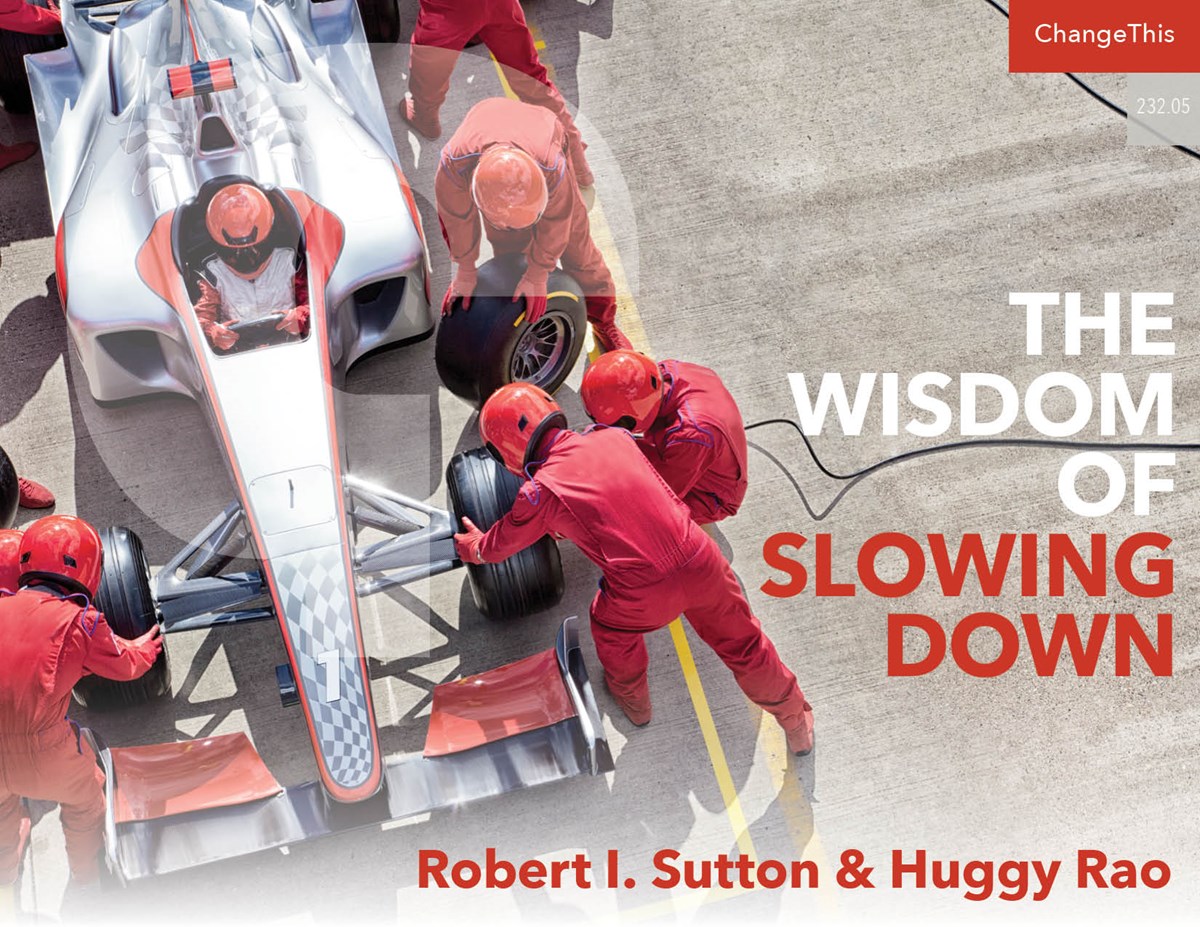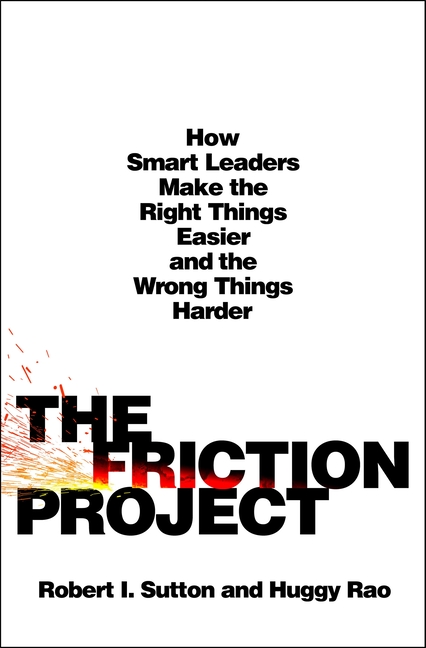The Wisdom of Slowing Down
January 31, 2024
Leaders often prioritize eliminating friction, but it's essential to slow down when necessary, according to Robert I. Sutton and Huggy Rao.
Too much speed at the wrong time kills people.
In 2020, a study by the U.S. Highway Traffic Safety Administration found that excessive speed contributed to 29 percent of all fatalities from traffic accidents.
Putting the pedal to the metal is dangerous for organizations, too.
London Business School’s Dana Kanze and her colleagues compared managers who were urged by their leaders to rush ahead, to focus on “locomotion goals,” to managers who were urged to slow down and evaluate their actions, to focus on “assessment goals.”
One of their studies tracked Equal Employment Opportunity Commission (EEOC) violations over a ten-year stretch by 559 U.S. franchises—corporations such as 7-Eleven, McDonald’s, Marriott, and Ace Hardware that sell, license, and oversee businesses that operate under their brands.
Dana and her colleagues classified corporations as focused on locomotion when their mission statements were packed with terms such as do it, fast, urgent, hurry, can’t wait, and launch. They classified corporations as focused on assessment when mission statements were filled with terms including careful, consider, right, evaluate, think, and thorough.
Of those 559 franchises, the 148 fined for violations including age, gender, and racial discrimination and sexual harassment used far more locomotion language in their mission statements than the other 411 franchises that weren’t fined.
Dana’s team also found that “just do it” lingo (compared to “do the right thing” language) caused more unlawful discrimination in a controlled experiment. They “randomly assigned 717 U.S.-based online participants to act as a manager of a franchise with a mission statement either high in locomotion or assessment.” When participants “read a mission statement that emphasized urgent action over thoughtful consideration,” it quadrupled their odds of taking unethical actions, including age discrimination against a sixty-one- year-old job applicant.
The Dangers of Postponing Work
As the damage caused by excessive speed ripples throughout an organization, it can turn into a vicious downward spiral that, once it gains momentum, is hard for leaders to reverse. As harried leaders make bad decisions and errors that create more pressing problems that are left unsolved, and one overwhelmed member after another burns out, turns selfish and nasty, makes more flawed decisions, and becomes less creative, everyone tangled up with the organization suffers.
Excessive speed also harms organizations when people postpone necessary work on the system, culture, or technology for too long—or never get around to it at all. In the world of software development, when coders defer necessary work, organizations incur “technical debt.” It builds up, for example, when engineers rush to ship code that has bugs or isn’t well-documented and tell themselves, “We will get to that later,” “Next time,” or “By the time it becomes a big problem, we will be working someplace else.”
Similarly, veteran tech executive Steve Blank wrote that many fast-moving and growing companies have excessive “organizational debt”—which “can kill the company even quicker” than technical debt. Steve defines organizational debt as compromises made to “just get it done.” Sometimes it’s necessary, and smart, to prioritize the most important work and get to the rest later. Yet, like borrowing too much money, so much organizational debt can accumulate that your company struggles to pay it down. Then, Steve says, “just when things should be going great, organizational debt can turn a growing company into a chaotic nightmare.”
The Importance of Good Endings
Anthropologists and sociologists document how, when something ends, people benefit from pausing to reflect on the past, what they’ve lost, what comes next, and what matters most and least to them—and to support one another. Be it the end of a meeting, a day, a game, a career, a life, a team, a project, or an organization.
We humans are wired to care about and be swayed by how things end. An insight from Nobel Prize winner Daniel Kahneman’s research is the “peak-end rule”: When people judge if a past experience is good or bad, they put the strongest weight on how they felt during the best and worst times, and at the end. They don’t simply judge the experience based on an average of how they felt throughout.
Friction fixers build good endings. In addition to writing a to-do list at the end of the day or week, you might encourage your colleagues to write a “ta-da list”—a ritual suggested by Gretchen Rubin, author of the book The Happiness Project. Gretchen says after listing your accomplishments—tasks you completed, people you helped, and ways you took care of yourself—you will feel proud and that it’s time for a well-deserved break, and you will be ready to go the next day or week.
Endings can reinforce the most precious values in a group, organization, or society. Such as the Sweeping the Shed ritual used by the All Blacks, New Zealand’s national rugby team. The All Blacks have been a superpower in rugby for more than a hundred years. Through 2020, they had an all-time winning percentage of 77 percent, the highest of any professional sports team in the world. James Kerr, who studied the team’s culture, says Sweeping the Shed is a mantra and ritual that reinforces “a tradition that says that no individual is bigger than the team and its ancestors.”
After every training session or match, no matter what role a person has on the team— janitor, player, manager—everyone pitches in and cleans the locker room. All Blacks’ legendary superstar Dan Carter explained, “From the very start, you learn humility . . . like the fact that we always leave the changing room as clean as it was when we walked in.”
A Tale of Two Endings
The differences between well-crafted and badly crafted endings are striking during employee layoffs. If you must lay people off, pause and remember there is a difference between what you do and how you do it.
Bird, the San Francisco–based electric scooter company, laid off more than four hundred employees in March 2020 at the start of the pandemic. The employees to be let go were invited to a generic-sounding Zoom meeting titled “COVID 19 update.” When employees logged on at 10:30 a.m., they encountered a slide that said, “COVID 19.”
Then, a two-minute audio-only meeting was led by a woman with a robotic voice—who didn’t identify herself and who few employees recognized. She began, “This is a suboptimal way to deliver this message,” then announced all employees on the call were losing their jobs—immediately. “Then their screens suddenly went dark and their company issued MacBooks restarted. By 10:40 a.m. everyone was locked out, just as employees were frantically trying to exchange personal numbers and emails on Slack and take screenshots of their contacts.”
After the layoffs, Bird’s CEO, Travis VanderZanden, was silent, and most fired employees heard little from the company. Except management was very concerned about getting back “company assets,” especially Mac laptops, which were useless to former employees as they were locked out.
In contrast, consider the layoffs led by CEO Brian Chesky at Airbnb.
On May 5, 2020, about a month after the Bird fiasco, Brian sent a memo to Airbnb employees announcing that about nineteen hundred people, 25 percent of the company, would lose jobs because of the abrupt drop in travel prompted by the COVID-19 crisis. Airbnb, he explained, would provide them generous severance benefits, including at least fourteen weeks of pay, twelve months of health insurance, and full vesting of company stock.
Brian also wrote, “We have great people leaving Airbnb, and other companies will be lucky to have them. The result is that we will have to part with teammates that we love and value...Please know this is not your fault. The world will never stop seeking the qualities and talents that you brought to Airbnb.”
The memo explained, if employees worked in the United States or Canada and lost jobs, each would be informed in a personal, one-on-one meeting with a senior manager—and their invitation would be sent in the next few hours. The last official workday for laid-off employees was May 11, 2020, to “give people time to begin taking next steps and say goodbye.” Brian announced a team of Airbnb recruiters would be dedicated to connecting laid-off alums with new employers, and each alum would get four months of support from RiseSmart, a career-services firm. All laid-off employees were allowed to keep their Airbnb laptop because it “is an important tool to find new work.”
That layoff was still a brutal blow to many Airbnb employees, who were disappointed that management had done so little to protect their jobs. And employees who still had jobs feared Airbnb’s caring and fun culture would never be the same again. Yet, after a few months, the wisdom of slowing down to do an orderly and compassionate layoff was clear—as was the need for a smaller and more nimble company. This “lesson in how to talk to your team in hard times,” as Inc. put it, helped remaining Airbnb employees regain confidence in their company’s leaders and culture. Most laid-off employees got good jobs within weeks. And Airbnb’s earnings bounced back as people began traveling again.
During the downturn in 2022 and 2023, several leaders of tech firms whom we know read Brian’s 2020 memo and talked with their top teams about the lessons for doing layoffs in their companies. They used it as a model for making cuts so that employees would still see their companies as good places to work and to protect the leaders’ personal reputations.
Both Travis VanderZanden at Bird and Brian Chesky at Airbnb were determined to build companies that eliminated as much friction—and brought as much joy and satisfaction—as possible for their customers. A big difference between the two was that Brian realized that, to build a company that achieved those goals, the onset of the pandemic was not a juncture where the easy way was the best way, or where the fast eat the slow.
Brian was much like other skilled friction fixers, hitting the gas and the brakes at the right moments. He knew that, to steer his company through treacherous obstacles, Airbnb was at a crossroads where it was best to slow down. To pause and figure out how to give the people his company was laying off the time, resources, and compassion they needed to help them land on their feet. While Brian was widely praised, Travis VanderZanden was vilified in the press and made excuses including blaming employees for spreading false rumors. (He tweeted, “We did NOT let employees go via a pre-recording.”)
The lesson for friction fixers, in the words of UCLA’s legendary basketball coach John Wooden (who won ten national championships in his final twelve years as coach), is “If you don’t have time to do it right, when will you have time to do it over?”
Adapted from The Friction Project: How Smart Leaders Make the Right Things Easier and the Wrong Things Harder by Robert I. Sutton and Huggy Rao, published by St. Martin’s Press. Copyright © 2024 by Robert I. Sutton and Huggy Rao.



